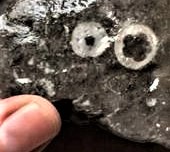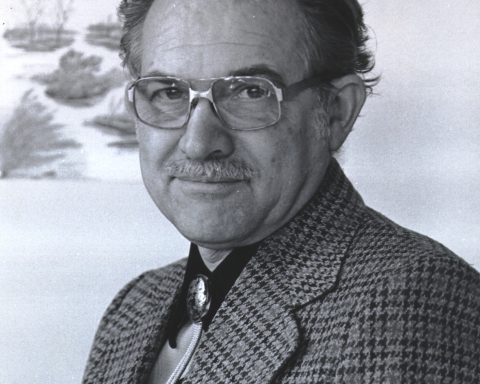Crinoid Columnals
The Catskill Geologists, The Mountain Eagle Jan. 15, 2021
Robert and Johanna Titus
We have about 1,400 members of our “The Catskill Geologist” facebook page. And many of them are very remarkable people. And they often send us such interesting photos. Recently we received an especially good one from Stephanie Theado from Bovina. Stephanie found some fossils along Schoharie Creek and wondered what they were. Take a look at her photo and see what you think.

Stephanie was most impressed by the flower shape within the one to the right. But what could these strange looking fossils be? There is no intuitively obvious answer to that question. That is unless you are an experienced geologist. These are very common fossils called crinoid columnals. To help you understand all this, first we have to tell you what a crinoid is. Crinoids are alive today; most of them are found on deep water sea floors. They are animals but look a lot like flowering plants. Hence, they are commonly called sea lilies. Take a look at our second illustration.

Crinoids are members of an invertebrate group called the Echinodermata. That makes them distant cousins of starfish and sea urchins. All are characterized by a very odd trait; they all, typically, have five-fold symmetry. That’s best displayed with the five arms of starfish but look again at Stephanie’s photo. Her “flower” has five petals, so typical of all echinoderms.
Sea lilies have usually lived on the bottoms of seas. They are typically rooted to the sea floor by a structure aptly called a holdfast. At their tops are structures called crowns. Crowns have arms equipped with net-like apparatus that filter food particles out of surrounding sea water. We call such creatures filter feeders. Connecting the holdfast with the crown is a long “stem.” That stem is composed of numerous skeletal elements called columnals. Again, look at our photo and see the holdfast, stem and crown.
It’s a rare day when a paleontologist finds a whole fossil crinoid. Typically, they decay and disarticulate after death. What we do find, more than anything else, are loose columnals, just like what Stephanie found. These are very common fossils, and you should take a good look at the photo; you are likely to see these from time to time. It’s a nice thing to know what they are.
It is not likely that these fossils are native to the strata along Schoharie Creek, unless that was at the far northern end of that valley. Stephanie’s fossils were almost certainly brought to where she found them by an ice age glacier. Glaciers may have done the same where you live. So, keep an eye out for these fossils.
Contact the authors at randjtitus@prodigy.net. Join their facebook page “The Catskill Geologist.” Read their blogs at “thecatskillgeologist.com.”





